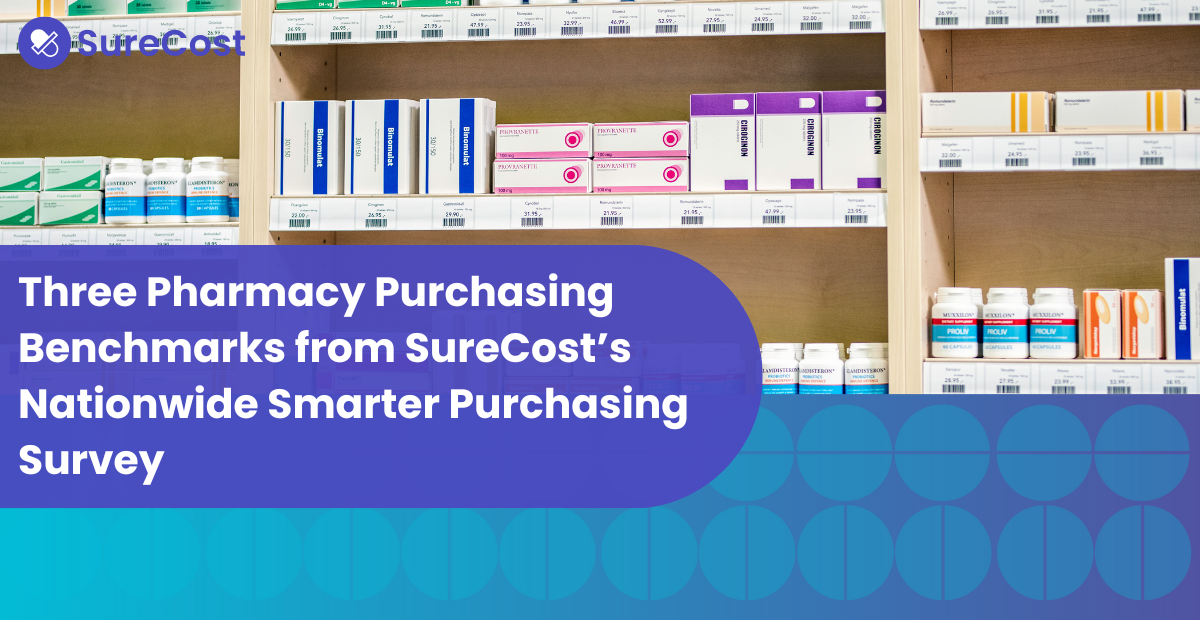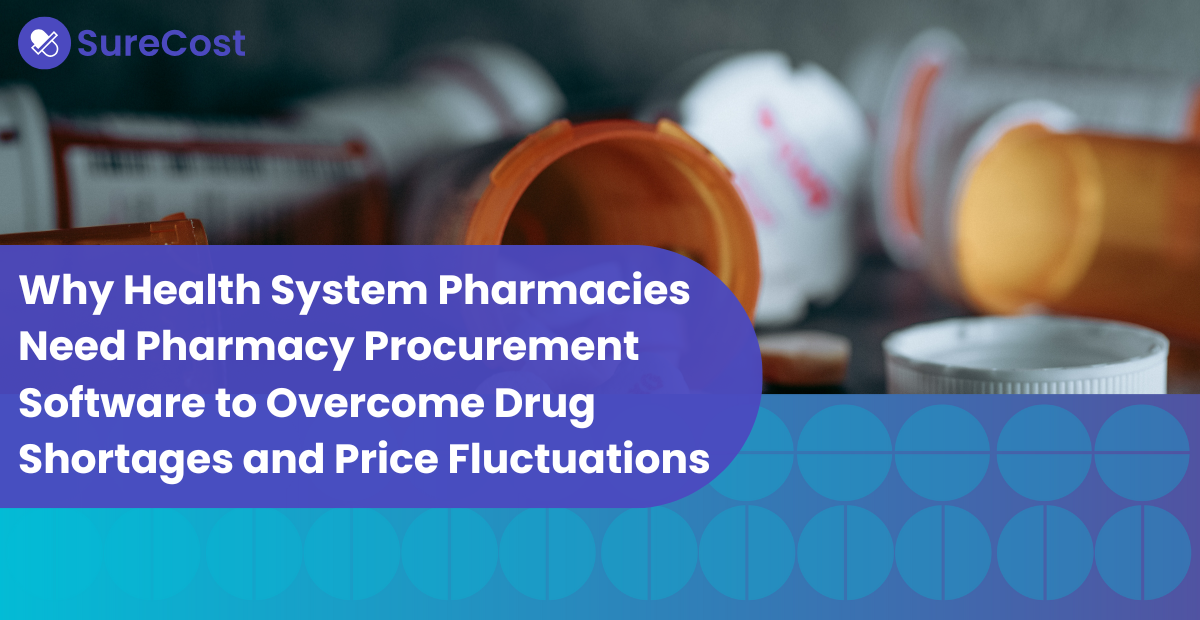The Inflation Reduction Act (IRA) provides significant savings on medications for Medicare recipients. This is great news for those patients, but it also means increased drug prices from drug manufacturers. They’ll need to make up for those losses somewhere, and their price hikes could sink your pharmacy’s cost of goods sold (COGS).
It’s unlikely that these trends will slow down (and it's reasonable to assume they’ll accelerate). That’s why pharmacies must find savings and decrease costs as much as possible in other areas.
This article will show how smarter purchasing can fortify your pharmacy in the face of increased drug prices. Technology designed for your pharmacy provides a unified purchasing and data-driven strategy to compensate for spiking drug prices. It also empowers you to optimize how you work while maintaining compliance. We’ll first cover why the IRA’s good news means challenges to your pharmacy’s margins.
The Impact of the IRA on Your Pharmacy
Medicare beneficiaries can look forward to the savings promised by the IRA. For example, manufacturers must pay the government a rebate if they raise the cost of a Medicare-covered drug faster than the inflation rate. That means lower prices for the patient—which is excellent! But one pharmacy veteran compares drug pricing with a balloon: squeeze one side, and it will pop out the other. Manufacturers will make up for the lower value somewhere. That’s when your pharmacy feels the pressure.
The chief adverse effects of the IRA on your pharmacy include:
- New drugs launch with higher prices because the “inflation penalty” changes how manufacturers set and raise prices
- Non-Medicare customers pay more for specific drugs as legislation disrupts pricing structures, changes the competitive landscape and causes manufacturers to make different portfolio decisions
- Commercial plans will pursue similar approaches to gain similar advantages in a changing market
Because the IRA reduces or even caps a manufacturer’s potential reimbursement, pharmacy benefits managers (PBMs) may also adjust their formulary to compensate for lower gross profit margins. Calvin Hunsicker, SureCost's Founder and Chief Product Officer, has observed some PBMS “engaging in cost-shifting practices that impact reimbursement dynamics which directly influence the amount a pharmacy must pay. This shift is product-dependent and often results in higher costs for the end-user.” He adds “Someone has to cover these additional expenses, and unfortunately, it often ends up being passed along to the pharmacy.”
The category of drugs being launched also results in higher prices. There are a lot more “specialty” and “biosimilar” products that address diseases very differently from traditional brand-name drugs (like oral solids used daily for blood pressure). That’s another win for patients, but these items cost more. At the same time, fewer manufacturers are launching fewer lower-priced generics, and less competition means “lower prices” aren’t that low.
Pharmacies must find ways to manage the significant impact of all these changes. How does it affect your purchasing? Are there better purchasing options? What does it do to your compliance ratios? How do you compensate for the impact on your COGS?
Leverage the Right Technology for Your Pharmacy
Chances are you didn’t go to pharmacy school to learn how to compare catalogs or negotiate with vendors. Yet purchasing is a crucial part of pharmacy management. Consistently finding the best options yields significant savings in the face of rising drug prices and other challenges. Likewise, failing to unlock these savings and always paying more than you should consume more money and time.
Embracing technology and automation is crucial for streamlining purchasing, inventory and compliance processes. Solutions exist for expanding your purchasing portfolio, comparing huge quantities of data and helping you determine the best purchasing choice. These tools also allow greater insight into your purchasing history and inventory levels. That knowledge can guide individual purchasing decisions and your overall business strategy.
Intelligent automation can reduce manual processes, identify savings and flag potential errors in your process. The best technology is flexible and integrates seamlessly with your existing systems (such as inventory, pharmacy management, accounts payable and DSCSA compliance protocols). Technology can never replace a trusted pharmacy professional, but it can enhance how you work through greater market transparency.
Unify Purchasing for Greater Transparency
Increased drug prices in an ever-changing purchasing ecosystem make procurement confusing, cumbersome and potentially costly. The market has always been opaque: a web of items, categories, pricing, vendors and interfaces makes it impossible to simply shop on your own. Purchasing is too often a tedious, time-consuming process that doesn’t even guarantee you’ve found the best purchasing option.
Instead, adopt a unified approach to purchasing. Solutions like SureCost enable pharmacies like yours to combine all vendor catalogs into one solution. That includes your primary vendor and any secondary vendors (which allows you to find even more savings by shopping outside the top 200).
Optimizing your purchasing improves how you navigate the market. You and your team gain tools to quickly compare thousands of purchasing options across vendors down to different packaging alternatives. You save money and time while eliminating an inefficient, tedious process.
Rely on Data to Drive Decisions
To mitigate the impact of increased drug prices, use data—preferably through customized reports—to gain visibility into purchasing trends and where you’re gaining or losing money. This could include maximizing your rebate potential from different vendors while ensuring primary vendor compliance, or you may discover costly inefficiencies in your inventory.
The right solution will provide a sophisticated set of information at your fingertips. To facilitate informed decision-making, you need advanced knowledge of item availability and quantities ordered by vendors, but make sure you find tools that do so quickly and easily.
Also, don’t leave data-driven strategy for when you have time to read the numbers. Use technology that lets you quickly and easily harness the right data to meet your pharmacy’s goals (and not just the information the software makes available).
Beyond Your Bottom Line
These challenges and strategies affect more than profits. When prices change or drugs aren’t available, patients look to their local pharmacy for answers. They rely on you and your team to provide outstanding care and trust that they’re getting the right products for the best price from you.
In other words, increased drug prices affect patients. If you’re spending hours trying to find better options, that means you’re losing time with them. It could affect your pharmacy’s relationship with them. They may find other providers with lower prices or who spend more time on the floor.
There’s no shortage of challenges facing pharmacies in 2024. Drug shortages, double DIR fees and new DSCSA requirements as well as high drug prices will affect your profits and workload. However, the right tools and strategies will empower your pharmacy to flourish despite these obstacles. Harness smarter purchasing. You’ll save money while improving how you work and staying compliant.
.png?w=500)



.png)



